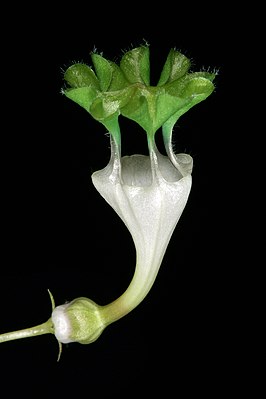Ceropegia rendallii
| Ceropegia rendallii | ||||||||||||
|---|---|---|---|---|---|---|---|---|---|---|---|---|

Ceropegia rendallii , flower |
||||||||||||
| Systematics | ||||||||||||
|
||||||||||||
| Scientific name | ||||||||||||
| Ceropegia rendallii | ||||||||||||
| NEBr. |
Ceropegia rendallii is a species of the subfamily of the silk plant family (Asclepiadoideae).
features
Vegetative characteristics
Ceropegia rendallii is a perennial herbaceous plant with a bulbous rhizome. The tuber is flattened and measures 2 to 7 cm in diameter. Occasionally there are also minor tubers. The winding, differently robust shoots are up to a meter long. They measure 1 to 2 mm in cross section and are green, with age they become reddish. The leaves are short stalked. The petiole is slender. The leaf blade is broadly ovate to heart-shaped, the apex is spiky. The dimensions are: 1 to 3 cm in length and 1 to 1.5 cm in width. The first leaves of a shoot are significantly larger than the later leaves. The somewhat fleshy leaves are green on top and gray-green on the underside.
Inflorescence and flowers
The long-lived inflorescence has a short stalk, up to five flowers appear one after the other from the inflorescence stalk. The hermaphrodite flowers are zygomorphic and five-fold with a double flower envelope. The flowers sit on short stems 3 to 6 mm long. The sepals are subpulate and 2 to 3 mm long. The whitish-greenish corolla is 1.8 to 2.8 cm high and almost straight to slightly curved. The cylindrical crown cup measures 5 mm in length and 3 mm in diameter. The upper half is almost spherical and approximately pentagonal in cross-section; strongly narrowed towards the corolla tube. This part of the crown is greenish with five purple stripes. Inside, the crown cauldron is purple and bare. The corolla tube has a minimum diameter of one millimeter. It is straight to moderately curved. It widens like a funnel towards the flower opening to 4 to 6 mm in diameter. It is whitish on the outside, only the base is pale purple. Inside it is whitish with purple stripes and covered with whitish hairs. The petals are around 3 mm long. The lower half is linearly shaped, stands upright and is curled back along the midrib. The upper half of the corolla lobes is heart-shaped and arranged horizontally, the two leaves of the lobes are spread out like a tent along the midrib. Overall, the petal lobes form an umbrella-like structure with an (upper) diameter of 6 to 12 mm. The lower halves of the petal lobes, bent back or rolled up, form ten pockets when viewed from above. The intensely green to brown-green colored shade of the corolla forms a strong contrast to the whitish flower tube. The free edges of the petal tips are covered with fine purple eyelashes. The whitish, cup-shaped secondary crown is sessile and has a diameter of 2.5 mm, with a height of 2 mm. The interstaminal corolla lobes form deep, egg-shaped pockets that are fused with the base. The edges are purple and are simple or with short, triangular appendages. They are covered with short hairs inside and out. The tips of the secondary staminal crown are broadly sickle-shaped, 2 mm long and 2 mm wide, upright and sloping together. From the middle they are strongly bent back. The pollinia are pointed and ovoid and measure 200 µm in length and 140 µm in width.
Similar species
Ceropegia rendalli is closely related to Ceropegia africana , Ceropegia multiflora and Ceropegia linearis , but differs significantly in the shape of the flower.
Geographical distribution and ecology
The range of the species includes northeastern South Africa ( KwaZulu-Natal , Limpopo Province , formerly Northern Province), Swaziland and Zimbabwe . Dyer also names the province of Maputo in southern Mozambique . The shoots die in the winter dry season and sprout again in spring when it rains.
Use by humans
In Botswana, the root tubers are collected and eaten by the local population.
Taxonomy
The species was described by Nicholas Edward Brown in March 1894 and named after the collector of the holotype P. Rendall. A more recent synonym is Ceropegia galpinii Schltr. (June 1894).
literature
- Ulrich Meve: Ceropegia . In: Focke Albers, Ulrich Meve (Hrsg.): Succulents Lexicon Volume 3 Asclepiadaceae (silk plants) . Pp. 61-107, Eugen Ulmer Verlag, Stuttgart 2002. ISBN 3-8001-3982-0
Individual evidence
- ^ R. Allen Dyer: Ceropegia, Brachystelma and Riocreuxia in Southern Africa. AA Balkema, Rotterdam, 1983, pp. 203-205.
- ↑ Dandy Badimo, Joyce Lepetu, Demel Teketay: Utilization of edible wild plants and their contribution to household income in Gweta Village, central Botswana. African Journal of Food Science and Technology, 6 (7): 220–228, 2015 doi : 10.14303 / ajfst.2015.074 PDF (at ResearchGate)
- ^ Nicholas Edward Brown: Bulletin of miscellaneous information / Royal Botanic Gardens, Kew, 1894 (87): 99-102, London 1894, p. 100/01.
